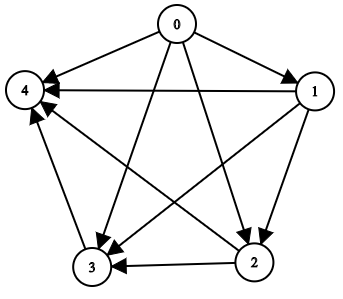You are given a positive integer n representing the number of nodes of a Directed Acyclic Graph (DAG). The nodes are numbered from 0 to n - 1 (inclusive).
You are also given a 2D integer array edges, where edges[i] = [fromi, toi] denotes that there is a unidirectional edge from fromi to toi in the graph.
Return a list answer, where answer[i] is the list of ancestors of the ith node, sorted in ascending order.
A node u is an ancestor of another node v if u can reach v via a set of edges.
Example 1:

Input: n = 8, edgeList = [[0,3],[0,4],[1,3],[2,4],[2,7],[3,5],[3,6],[3,7],[4,6]] Output: [[],[],[],[0,1],[0,2],[0,1,3],[0,1,2,3,4],[0,1,2,3]] Explanation: The above diagram represents the input graph. - Nodes 0, 1, and 2 do not have any ancestors. - Node 3 has two ancestors 0 and 1. - Node 4 has two ancestors 0 and 2. - Node 5 has three ancestors 0, 1, and 3. - Node 6 has five ancestors 0, 1, 2, 3, and 4. - Node 7 has four ancestors 0, 1, 2, and 3.
Example 2:

Input: n = 5, edgeList = [[0,1],[0,2],[0,3],[0,4],[1,2],[1,3],[1,4],[2,3],[2,4],[3,4]] Output: [[],[0],[0,1],[0,1,2],[0,1,2,3]] Explanation: The above diagram represents the input graph. - Node 0 does not have any ancestor. - Node 1 has one ancestor 0. - Node 2 has two ancestors 0 and 1. - Node 3 has three ancestors 0, 1, and 2. - Node 4 has four ancestors 0, 1, 2, and 3.
Constraints:
1 <= n <= 10000 <= edges.length <= min(2000, n * (n - 1) / 2)edges[i].length == 20 <= fromi, toi <= n - 1fromi != toi- There are no duplicate edges.
- The graph is directed and acyclic.
Solution: DFS
For each source node S, add it to all its reachable nodes by traversing the entire graph.
In one pass, only traverse each child node at most once.
Time complexity: O(VE)
Space complexity: (V+E)
C++
|
1 2 3 4 5 6 7 8 9 10 11 12 13 14 15 16 17 18 19 20 21 22 23 |
// Author: Huahua class Solution { public: vector<vector<int>> getAncestors(int n, vector<vector<int>>& edges) { vector<vector<int>> ans(n); vector<vector<int>> g(n); for (const auto& e : edges) g[e[0]].push_back(e[1]); function<void(int, int)> dfs = [&](int s, int u) -> void { for (int v : g[u]) { if (ans[v].empty() || ans[v].back() != s) { ans[v].push_back(s); dfs(s, v); } } }; for (int i = 0; i < n; ++i) dfs(i, i); return ans; } }; |
请尊重作者的劳动成果,转载请注明出处!花花保留对文章/视频的所有权利。
如果您喜欢这篇文章/视频,欢迎您捐赠花花。
If you like my articles / videos, donations are welcome.



Be First to Comment